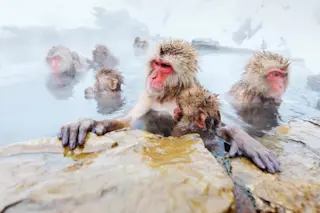Forget Planet of the Apes. Earth has long been the planet of the monkeys. With over 330 species, monkeys are a diverse group of primates, split into two major lineages: Old World monkeys of Africa and Asia, and New World monkeys of South and Central America.
Apes — including gorillas, chimpanzees and humans — are merely an offshoot of the Old World branch. Some 15 million years ago, apes flourished as a group, but they’ve dwindled to a handful of species, a near evolutionary dead-end of animals “barely managing to scrape it together, while the monkeys clearly have things figured out,” says Duke University primate evolution expert Matthew Borths.
Size is one way to distinguish between hulking apes and more diminutive monkeys: Male gorillas can weigh over 400 pounds, but monkeys max out at the 80-pound mandrill.
Monkeys also have tails, which apes lost through evolution. “I’ve often thought that ...















